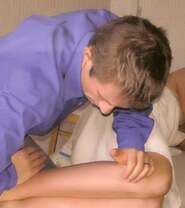|
What is osteopathy?
Osteopathy is based on relationships between the body’s structure and the way it functions. For example, if muscles surrounding a hip joint are stiff, the range of movement of not only that hip joint will be reduced, but also joints such as the opposite hip, knee and ankle joints. Additionally, links may be made between the patient’s presenting complaint and other medical and psychosocial factors. As such, taking a detailed case history is essential to diagnosis and treatment and patient self-help.
Of equal importance is the examination where an osteopath will observe patients’ general posture and movement in conjunction with tests that examine ranges of motion in structures local, adjacent and distant to the area of complaint. Findings from an examination can be confirmed or denied with investigations such as imaging techniques and other clinical investigations. |

Once a diagnosis has been made and the patient is safe to treat, a wide range of non-invasive techniques such as deep and superficial soft tissue techniques, joint articulation and manipulation can be applied therapeutically. Furthermore, an osteopath can also recommend complementary assessment and treatment from other healthcare professionals that can help with other factors either raised in the case history or that become apparent during the management of the patient. In Australia, osteopaths are university trained in anatomy, physiology, pathology, general medical diagnosis and osteopathic techniques. Osteopaths are trained to recognise conditions that require medical referral and are also trained to carry out standard medical examinations of the musculoskeletal, cardiovascular, respiratory, abdominal and nervous systems. Osteopathy is covered by most private health funds and the Chronic Disease Management (CDM) scheme. Osteopaths are also registered providers for workers compensation schemes, motor accident insurers and the Department of Veterans' Affairs. |

